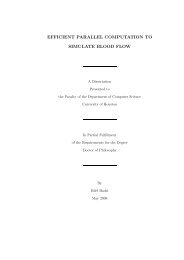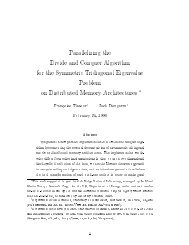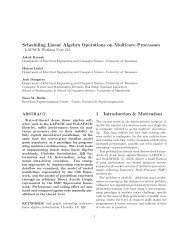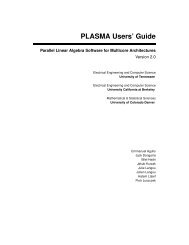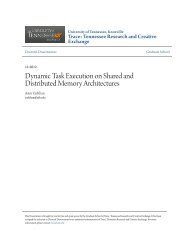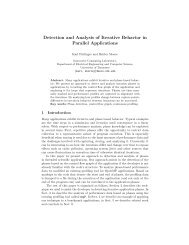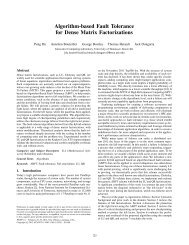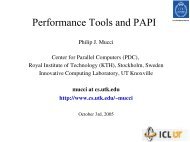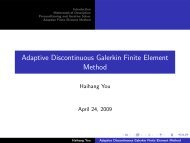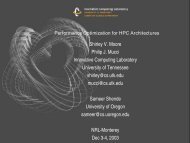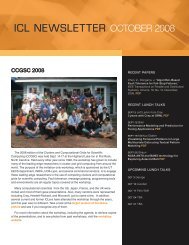Fast and Small Short Vector SIMD Matrix Multiplication ... - The Netlib
Fast and Small Short Vector SIMD Matrix Multiplication ... - The Netlib
Fast and Small Short Vector SIMD Matrix Multiplication ... - The Netlib
You also want an ePaper? Increase the reach of your titles
YUMPU automatically turns print PDFs into web optimized ePapers that Google loves.
At this point, the loop body still contains auxiliary<br />
operations that cannot be overlapped with arithmetic<br />
operations. <strong>The</strong>se include initial loads, stores of final<br />
results, necessary data rearrangement with splats<br />
<strong>and</strong> shuffles, <strong>and</strong> pointer advancing operations. This<br />
problem is addressed by double-buffering, on the<br />
register level, between two loop iterations. <strong>The</strong> existing<br />
loop body is duplicated <strong>and</strong> two separate blocks<br />
take care of the even <strong>and</strong> odd iteration, respectively.<br />
Auxiliary operations of the even iteration are hidden<br />
behind arithmetic instructions of the odd iteration<br />
<strong>and</strong> vice versa, <strong>and</strong> disjoint sets of registers are<br />
used where necessary. <strong>The</strong> resulting loop is preceeded<br />
by a small body of prologue code loading<br />
data for the first iteration, <strong>and</strong> then followed by a<br />
small body of epilogue code, which stores results of<br />
the last iteration. Figure 1 shows the optimization<br />
steps leading to a high performance implementation<br />
of the GEMM inner kernel.<br />
5.3 C = C – A × B trans<br />
FOR each element<br />
FOR each element<br />
FOR each element<br />
FOR each tile<br />
FOR each tile<br />
FOR each tile<br />
FOR each element<br />
FOR each element<br />
FOR each element<br />
FOR each tile – 1D space<br />
FOR each tile – 1D space<br />
FOR each tile – 1D space<br />
arithmetics & memory<br />
canonical<br />
form<br />
unrolling<br />
tiling<br />
<strong>The</strong> BLAS C = C − A × B T GEMM is a very<br />
common linear algebra operation. LAPACK relies<br />
on this operation for implementation of many matrix<br />
transformations, including Cholesky factorization<br />
( POTRF), LDL T factorization ( SYTRF), QR<br />
factorization ( GEQRF - calling GEMM indirectly<br />
through the LARFB routine), <strong>and</strong> bidiagonal reduction<br />
( GEBRD). <strong>The</strong> C = C − A × B T micro-kernel<br />
is also a building block for Level 3 BLAS routines<br />
other than GEMM, e.g., symmetric rank k update<br />
( SYRK).<br />
Specifically, implementation of the Cholesky factorization<br />
for the CELL processor, based on this<br />
micro-kernel coded in C, has been reported by the<br />
authors of this publication [24].<br />
Before going into details, it should be noted, that<br />
matrix storage follows C-style row-major format. It<br />
is not as much a carefull design decision, as compliance<br />
with the common practice on the CELL processor.<br />
It can be attributed to C compilers being the<br />
only ones allowing to exploit short-vector capabilities<br />
of the SPEs through C language <strong>SIMD</strong> extensions.<br />
If compliance with libraries relying on legacy<br />
FOR each tile – 3D space<br />
arithmetics & memory<br />
FOR each pair of tiles<br />
arithmetics<br />
(even iteration)<br />
arithmetics<br />
(odd iteration)<br />
memory<br />
(odd iteration)<br />
memory<br />
(even iteration)<br />
pieplining<br />
linearization<br />
(doublebuffering)<br />
Figure 1: Basic steps of GEMM loop optimization.<br />
FORTRAN API is required, a translation operation is<br />
necessary. However, translation is required anyway,<br />
since implementations of dense linear algebra routines<br />
on the CELL processor rely on Block Data Lay-<br />
5



